Buddhism
Buddhism, founded by Siddhartha Gautama(Gautama Buddha) in the 6th century BCE in ancient India, is a spiritual tradition centered on the pursuit of enlightenment. The core teachings, encapsulated in the Four Noble Truths and the Eightfold Path, emphasize the nature of suffering, its cause, and the path to liberation through ethical conduct, mental discipline, and wisdom. Buddhism has diverse schools and has spread globally, influencing philosophy, art, and meditation practices.
Indian Knowledge System:
❖ In News:Recently, the University Grants Commission (UGC) has proposed draft guidelines to incorporate India Knowledge System (IKS) into higher education curricula.
❖ The UGC’s objective is to enhance students’ understanding of IKS and its relevance in contemporary times, fostering a deeper appreciation of India’s knowledge heritage.
About Indian Knowledge System
❖ It refers to the systematised disciplines of knowledge developed in India from ancient times and the traditions and practices preserved by various communities.
❖ The UGC aims to introduce courses on IKS to provide students with a comprehensive view of India as a knowledge-based society and explore the connections between ancient Indian knowledge and contemporary disciplines, contributing to sustainable human communities.
❖ The proposed changes suggest that every undergraduate and postgraduate student should be encouraged to take credit courses in IKS.
➢ a mathematics student- numbers, fractions, and geometry in the Vedas
➢ history student related to history.
➢ Students of modern medicine Indian Systems of Medicine, such as Ayurveda, Siddha, Yoga, Naturopathy,Unani, or Homeopathy.
❖ Other suggested courses include the geographical isolation of India, the uniqueness of Indian culture, epics like Ramayana and Mahabharata, Puranas, foundational texts of Indian philosophies (including Jainism and
Buddhism), and texts of Indian religious traditions.
❖ Astronomy- ancient celestial observations in the Vedic corpus and the – scientific determination of time,place, and direction through the motion of celestial bodies are proposed.
❖ Concept of “Chakravartin” (universal ruler) in Hindu and Buddhist traditions within the Indian polity and economy segment.
Origin of Buddhism and Jainism:
❖ The Varna-divided society generated tensions in ancient India.
❖ The responses of the vaishyas and Shudras are unknown, but the Kshatriyas, who served as the ruling class,strongly objected to the brahmanas’ ritualistic dominance and organised a kind of protest against the Varna system’s emphasis on birth.
❖ The Kshatriya reaction against the domination of the Brahmans, who claimed various privileges,
was one of the causes of the origin of new religions.
❖ Vardhamana Mahavira, who really founded
Jainism, and Gautama Buddha, who founded
Buddhism, belonged to the Kshatriya clan, and
both disputed the authority of the Brahmanas.
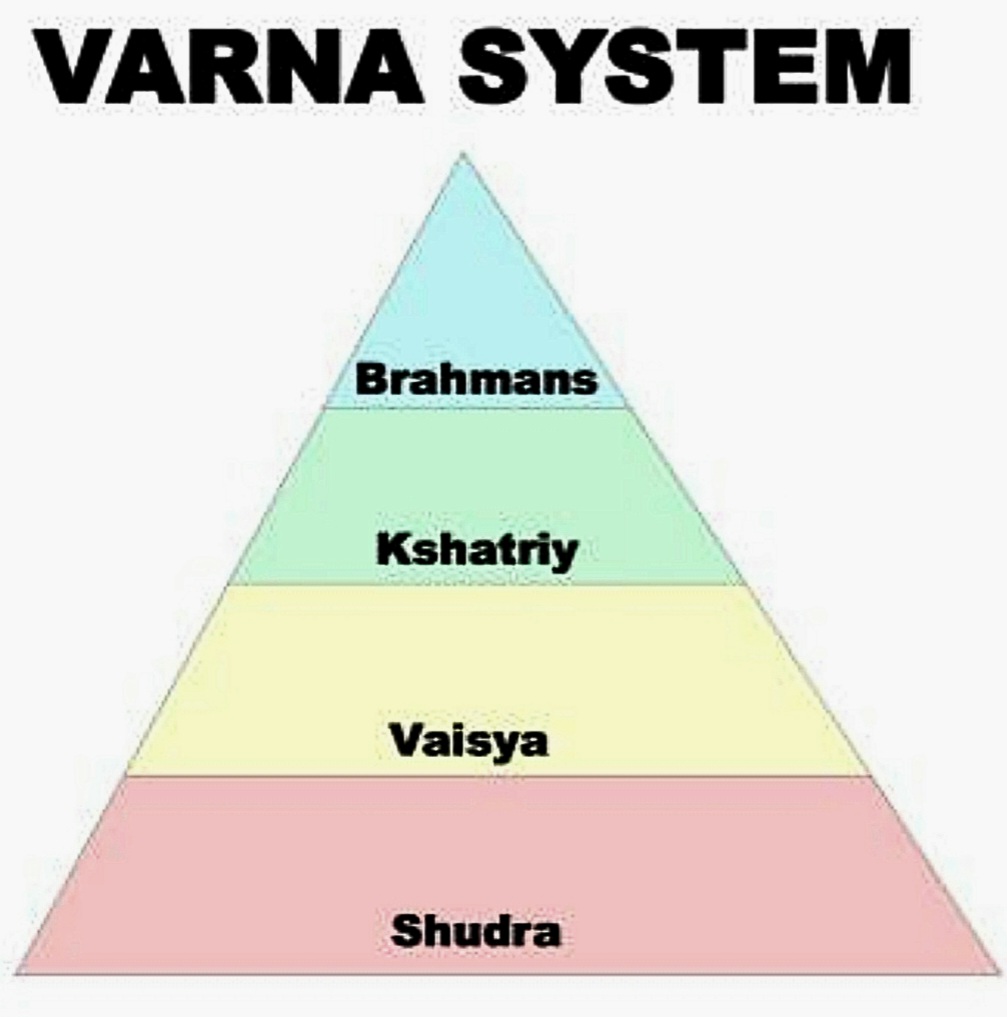
Literary Source of Buddhism:
❖ Tripitaka/ Three baskets of Buddhist scripture:
➢ Sutta Pitaka: Sutra related to Buddha and
companion
➢ Vinaypitaka: Monastic rules.
➢ Abhidhampitaka: Doctrine and philosophy of Buddhism
❖ Jataka Folklore: stories related to the birth of Buddha/in Chinese they are called Sadok.
❖ Milindapanha: Questions of Milinda i.e Greek king Meander and answers of Buddhist monk Nagasena.
❖ Ceylonese Chronicles: Mahavamsa by Mahanama, Dipavamsa, and Attakatha by Wattagamani.
❖ Tibetan Chronicles: Divyavadana-Kalachakra.
Role of Agriculture in the rise of the New Religion:

❖ The real cause of the rise of these new religions lay in the spread of a new agricultural economy in north-eastern India.
❖ In North-east India, including the regions of eastern UP and northern and southern Bihar, has about 100 cm of rainfall. Before these areas were colonised on a large scale, they were densely forested and could not be easily cleared without the aid of iron axes.
❖ In the mid-Gangetic plains, large-scale habitations began towards the end of the sixth century BC, when iron began to be used in this area on some scale.
❖ The agricultural economy based on the iron ploughshare required the use of bullocks, and could not flourish without animal husbandry.
❖ However, the Vedic practice of killing cattle indiscriminately in sacrifices hampered the progress of the new agriculture.
❖ The cattle wealth was gradually decimated because they were being killed in the course of the numerous Vedic sacrifices. However, if the new agrarian economy was to stabilise, this killing had to be halted.
Why does Buddhism receive enormous support from Vaishyas?
Background:
❖ Rise of Urbanisation: The rise of a large number of cities in North and Eastern India during 500 BC like Kaushambi near Allahabad, Kushinagar (in Deoria district of UP), Varanasi, Vaishali (in the newly created district of the same name in north Bihar), Chirand (in Saran district), Taradih in Bodh-Gaya, Pataliputra, Rajgir
(situated at a distance of about 100 miles south-east of Patna), and Champa in Bhagalpur district.
❖ Use of Punched Marked Coins: Many artisans and traders used coins for the first time. The earliest coins date to the 5th century BC and were often punch-marked. In eastern UP and Bihar, they were initially seen in circulation.
Coinage naturally promoted trade and business, which increased the vaishyas’ significance in the
Brahmanical society.
Reasons for Support:
❖ All this made vaishyas to lean towards a religion that would improve their social position.
❖ Also, neither Jainism or Buddhism attached any importance to the existing Varna System.
❖ They preached Non-Violence which would put an end to wars b/w different kingdoms and consequently promote trade and commerce.
❖ Dharmasutra, a brahminical text, denounced lending money on interest. Vaishyas who used to lend money,found the system an impediment in improving their social and economic status.
Concept of New Form of Property and Materialism:
❖ New form of property: As the result of increasing trade and commerce, accumulation of wealth was becoming the name of the game. New forms of properties such as coins, silver, gold, etc. created social inequalities and caused misery and suffering to masses.
❖ All this prompted common people to return to a primitive and ascetic way of life- something which was offered by Jainism and Buddhism.
❖ The Buddhist and Jain monks opposed all kinds of materialism. They were not even allowed to touch gold and silver.
❖ They were to accept only that much from their patrons as was required to keep their body and soul together.
Special Features of Buddhism Which Became the Reasons for the Spread and Popularity of Buddhism:
❖ Non-recognition of God: Simple concepts characterized early Buddhism. It avoided engaging in the clap-trap of philosophical discussion.Being critical of the varna structure helped Buddhism gain the support of those
from lesser varnas.
❖ Liberal & democratic: Unlike Brahmanism, it was far more liberal & democratic. It won the hearts of the lower class as it attacked the varna system.
❖ Incorporation of women into the sangha: Women were also added to the Sangha of Buddhist monks.So,women’s support for Buddhism was natural.
❖ Simple language: The Pali language which Buddha used was the spoken language of the masses.
❖ Indo-Gangetic belt: Magadh presented a ground for its spread Buddhism made a special appeal to the people in non-Vedic areas. Magadha was placed outside the pale of the holy Aryavarta, the land of Aryans, covering
modern U.P..
❖ Personality of the Buddha: He was kind and ego-less. His calm composure, sweet words of a simple philosophy, and his life of renunciation drew the masses to him.
❖ Royal patronage: Kings like Prasenjit, Bimbisara, Ashoka, and Kanishka patronized Buddhism and helped its spread throughout India and outside as well. Ashoka deputed his children to Sri Lanka for the spread of Buddhism.
❖ Inexpensive: Buddhism was inexpensive, without the expensive rituals that characterized the Vedic religion.
Great World teachers in the 6th century BCE all over the World:
❖ Basic Philosophy they preached:
➢ Questioned socio-religious norms.
➢ Focused on ethical and moral values.
➢ Said true happiness does not lie in material prosperity.
➢ Condemned performance of rituals.
➢ Promoted non-violence, charity, frugality, and good social conduct.
❖ Some Leaders or Preachers:
➢ Confucius in China.
➢ Zoroaster in Iran.
➢ Parmenides in Greece.
➢ Buddhism and Jainism in India.
❖ Sources about life of Buddha: Sutta and Vinaya Pitakas, Buddhacarita, Mahavastu Nidanakatha.
Life of Buddha
❖ Name: Siddhartha
❖ Other names: Sakyamuni / Tathagata
❖ Year and Day: 563 BCE on Vaishakha Purnima day
❖ Birth Place: Lumbini (near Kapilavastu, Nepal)
Siddhartha or Gautam Buddha:
❖ Birth: 563 BC** (Debatable)
❖ Father: Suddhodana
➢ He was an elected chief of the republican Shakya clan.
➢ His capital was Kapilavastu.
➢ Later annexed by the Kosala kingdom during the Buddha’s lifetime.
❖ Gautama was the family name.
❖ Mother: MahaMaya (Mayadevi)
➢ Koliyan (Kosala) princess.
➢ Legend has it that, on the night Siddhartha was conceived (this event is called Avikranti, denoted as white elephant), Queen Maya dreamt that a white elephant with six white tusks entered her right side.

➢ She gave birth and died seven days after his birth.
➢ Buddha was raised by his step-mother Gautami.Hence, Buddha is also known as Siddhartha Gautama.
Buddha’s birth:
❖ Theravada countries called it Vesak.
❖ Buddha Purnima in Nepal, Bangladesh, and India as he is believed to have been born on a full moon day.
❖ Brahmanas saw 32 marks of a Mahapurusha on his body and predicted either world conqueror or a world renouncer.
❖ The infant was given the name Siddhartha, meaning “he who achieves his aim”.
❖ Hermit seer Asita announced that the child would either become a great king (chakravartin) or a great sadhu.
This occurred in a later stage.
❖ Kondanna: He was reputed to be the only one who unequivocally predicted that Siddhartha would become a Buddha.
❖ Buddha’s birth is symbolised through Bull and Lotus.
❖ Siddhartha grew up in Kapilavastu. Though the exact site is unknown. It may have been either Piprahwa,Uttar Pradesh, or Tilaurakot, in Nepal.
❖ Both places belonged to the Sakya (Kshatriya) territory, and are located only 15 miles apart.
Early Life and Marriage:
❖ Siddhartha was brought up by his mother’s younger sister, Mahapajapati.
❖ By tradition, he is said to have been destined by birth to the life of a prince and had three palaces built for him.
❖ His father, wishing for his son to be a great king, is said to have shielded him from religious teachings and from knowledge of human suffering.
❖ At 16, his father reputedly arranged his marriage to Yasodhara, she gave birth to a son, named Rahula.
❖ Siddhartha is said to have spent 29 years as a prince.
❖ Although his father ensured that Siddhartha was provided with everything he could want or need , Buddha renounced all and left home in quest for truth.
Renunciation and Ascetic Life- Mahabhinishkramana:
❖ At the age of 29, Siddhartha left his palace to meet his subjects.
❖ Despite his father’s efforts to hide from him the sick, aged and suffering, Siddhartha was said to have seen an old man.
❖ When his charioteer, Channa, explained to him that all people grew old, the prince went on further trips beyond the palace.
On these he encountered:
➢ an old man
➢ diseased man
➢ a decaying corpse
➢ an ascetic.
❖ These depressed him, and he initially strove to overcome ageing, sickness, and death by living the life of an ascetic.
❖ Accompanied by Channa and riding his horse Kanthaka,Gautama quit his palace for the life of a mendicant and wandered for six years.

❖ Gautama initially went to Rajagaha and began his ascetic life by begging for alms in the street.
❖ King Bimbisara offered Siddhartha the throne after his troops recognised him and the king knew of his mission. Siddhartha declined the offer but agreed to travel to Magadha first once he attained enlightenment.
❖ He left Rajagaha and practised under two hermit teachers of yogic meditation.
➢ After mastering the teachings of Alara Kalama (Sankhya philosopher), he was asked by Kalama to succeed him.
➢ However, Gautama felt unsatisfied by the practice, and moved on to become a student of yoga with Udaka Ramaputta.
➢ With him he achieved high levels of meditative consciousness and was again asked to succeed his teacher.But, once more, he was not satisfied, and again moved on.
❖ He was not convinced with their instructions that man could obtain liberation from sorrow by mental discipline and knowledge only.
❖ Later on, accompanied by five wandering ascetics: Kondanna, Bhaddiya, Vappa, Mahanama and Assaji.
Along with them, he practised severe austerities until his body was almost emaciated. Realising that austerities could not lead to realisation, he abandoned them.
❖ His five ascetic companions, disgusted at his seeming failure, deserted him and left for Sarnath. He then moved towards the village of Senani, where he was offered a bowl of milk-rice by a low-caste village girl, Sujata.
❖ Accepting from a grass-cutter a gift of kusa grass for a mat, he took a seat under a Peepal tree facing east.
Here he resolved not to rise again until enlightenment was attained.
➢ ‘Here on this seat my body may shrivel up,
➢ my skin, my bones, my flesh may dissolve,
➢ but my body will not move from this seat
➢ until I have attained Enlightenment,
➢ so difficult to obtain in the course of many kalpas’.
Mara Vijaya:
❖ As Gautama sat in deep meditation, Mara, the Lord of illusions, perceiving that his power was about to be broken, rushed to distract him from his purpose.
❖ Gautama touched the earth, calling it to bear witness the countless lifetimes of virtue that had led him to this place of enlightenment.
❖ When the earth shook, confirming the truth of Gautama’s words, Mara unleashed his army of demons.
❖ In the epic battle that ensued, Gautama’s wisdom broke through the illusions and the power of his compassion transformed the demons’ weapons into flowers.
❖ Mara and all his forces fled in disarray.
Awakening:
❖ Gautama was famously seated under a pipal tree now known as the Bodhi tree (peepal) in Uruvela (Bodh Gaya, India) on the bank of Niranjan River [now Falgu] when he vowed never to arise until he had found the truth.
❖ After 49 days of meditation, he is said to have attained Enlightenment, and became known as the Buddha or “Awakened One”.
❖ Thus, at the age of 35, he ultimately attained Nirvana/Enlightenment.
❖ Gautama discovered what Buddhists know as being, the Middle Way—a path of moderation away from the extremes of self-indulgence and self-mortification, or the Noble Eightfold Path, as described in the Dhammacakkappavattana Sutta, which is regarded as the first discourse of the Buddha.
❖ The Peepal tree was known as the famous Bodhi tree.
❖ It is believed that Asoka’s queen Tissarakkha was jealous of the tree, and three years after she became queen (i.e., in the nineteenth year of Ashoka’s reign) she caused the tree to be killed by means of mandu thorns.The tree, however, grew again.
❖ The tree was again cut down by King Pushyamitra Shunga in the second century BCE, and by King Shashanka in 600 AD.
❖ Every time the tree was destroyed, a new tree was planted at the same place; and this tree at Bodh Gaya is still revered by Buddhists.
What is Nirvana?
❖ Nirvana is the extinguishing of the "fires" of desire, hatred, and ignorance, that keep the cycle of suffering and rebirth going. Nirvana is alsoegarded as the "end of the world", in that no personal identity or boundaries of the mind remain.
First sermon or the Dharmachakra Pravartana:
❖ He then travelled to the Deer Park [Sarnath] near Varanasi (Benares) in northern India.
❖ Here he set in motion what Buddhists call the Wheel of Dharma/ Dhamma Chakka-Pavattana by delivering his first sermon to the five companions with whom he had sought enlightenment.
❖ All five disciples become arahants.
❖ Together with him, they formed the first sangha (the company of Buddhist monks).
Sangha:
❖ Within the first two months, with the conversion of Yasa and fifty-four of his friends, the number of such arahants is said to have grown to 60.
❖ The conversion of three brothers named Kassapa followed, with their reputed 200, 300 and 500 disciples,respectively. This swelled the sangha to more than 1,000.
❖ The Buddha intended to visit Asita, and his former teachers, Alara Kalama and Uddaka Ramaputta, to explain his findings, but they had already died.
❖ The Buddha wandered about, teaching his doctrine for over four decades, and established an order of monks and nuns known as the Sangha.
Buddha’s Disciples:
❖ Of the Buddha’s disciples, five closest to him are:
➢ Sariputta
➢ Maudgalyayana
➢ Mahakasyapa
➢ Ananda
➢ Anuruddha
❖ Women Disciples:
➢ Yashodhara
➢ Gautami
➢ Sujata
➢ Amrapali
➢ Vishakha
➢ Khema
➢ Malika
Travels and Teachings of Buddha:
❖ The Buddha is claimed to have spent the remaining 45 years of his life teaching a wide variety of people in the Gangetic Plain, including nobles. servants, murderers like Angulimala, and cannibals like Alavaka.
❖ Although the Buddha’s language remains unknown, it’s likely that he taught in one or more of a variety of closely related Middle Indo-Aryan dialects, of which Pali may be a standardisation.
❖ The sangha travelled the subcontinent while presenting the dharma.
➢ Except for the four months of the Vassa rainy season, when ascetics of all religions rarely travelled,this persisted throughout the year. At this time of year, the sangha would retreat to monasteries, public parks or forests, where people would come to them.
❖ The first vassana was spent at Varanasi when the sangha was formed.
Buddha and Amrapali
❖ In Buddhist records, Amrapali is noted as having had the opportunity to serve food to the Buddha during his last visit to Vaishali, shortly before his death.
❖ Amrapali attended his sermon at a nearby grove and was so deeply moved by it that she invited him for a meal at her quarters.
❖ After this, the Buddha kept a promise to travel to Rajagaha, capital of Magadha, to visit King Bimbisara.
❖ During this visit, Sariputta and Maudgalyayana were converted by Assaji, one of the first five disciples,after which they were to become the Buddha’s two foremost followers.
❖ The Buddha spent the next three seasons at Veluvana Bamboo Grove monastery in Rajagaha, the capital of Magadha.
❖ Anathapindika of Shravasti donated Jetavana to Buddha.
❖ Buddha visited: Sarnath, Mathura, Banaras, Rajgir, Vaishali, Nalanda and Pataliputra
❖ Suddhodana sent, over a period, ten delegations to ask him to return to Kapilavastu.
➢ 9 delegations joined the sangha to become arahants.
➢ The tenth delegation, led by Kaludayi, a childhood friend of Gautama’s (who also became an arahant),however, delivered the message.
➢ Now two years after his awakening, the Buddha agreed to return, and made a two-month journey by foot to Kapilavastu, teaching the dharma as he went.
❖ At his return, the royal palace prepared a midday meal, but the sangha was making an alms round in Kapilavastu.
❖ The Buddha’s cousins Ananda and Anuruddha became two of his five chief disciples.
❖ At the age of seven, his son Rahula also joined, and became one of his ten chief disciples.
❖ His half-brother Nanda also joined and became an arahant.
Do you know?
❖ In 2016, the Ministry of Tourism announced the Buddhist Circuit as the country’s first transnational tourism circuit, covering sites in Nepal and Sri Lanka alongside those in India.
❖ The ministry’s map of the Buddhist Circuit includes Bodh Gaya, Vaishali, and Rajgir in Bihar,Kushinagar, Sarnath, and Shravasti in UP, and Lumbini in Nepal.
Ordination of Women as Nuns:
❖ Father’s death and cremation was to inspire the creation of an order of nuns.
❖ Buddhist texts record that the Buddha was reluctant to ordain women.
❖ His foster mother Maha Pajapati, approached him, asking to join the sangha, but he refused.
➢ Maha Pajapati, however, was so intent on the path of awakening that she led a group of royal Sakyan and Koliyan ladies, which followed the sangha on a long journey to Rajagaha.
❖ In time, after Ananda championed their cause, the Buddha is said to have reconsidered and, five years after the formation of the sangha, agreed to the ordination of women as nuns.
❖ He reasoned that males and females had an equal capacity for awakening. But he gave women additional rules (Vinaya) to follow.
Kings who accepted his Doctrine:
❖ Bimbisara and Ajatshatru (Magadha)
❖ Prasenjit of Koshala
❖ Udayana of Kaushambi
❖ Buddha’s father and foster mother Prajapati
Mahaparinirvana (Final blowing out- 483 BC):
❖ According to the Mahaparinibbana Sutta of the Pali canon, at the age of 80, the Buddha announced that he would soon reach Parinirvana, or the final deathless state, and abandon his earthly body.
❖ After this, the Buddha ate his last meal, which he had received as an offering from a blacksmith named Cunda.
❖ When Buddha became seriously ill, he gave his attendant Ananda instructions to persuade Cunda that his supper, which served as the final
meal for a Buddha, had nothing to do with his departure and would instead be a source of the greatest virtue.
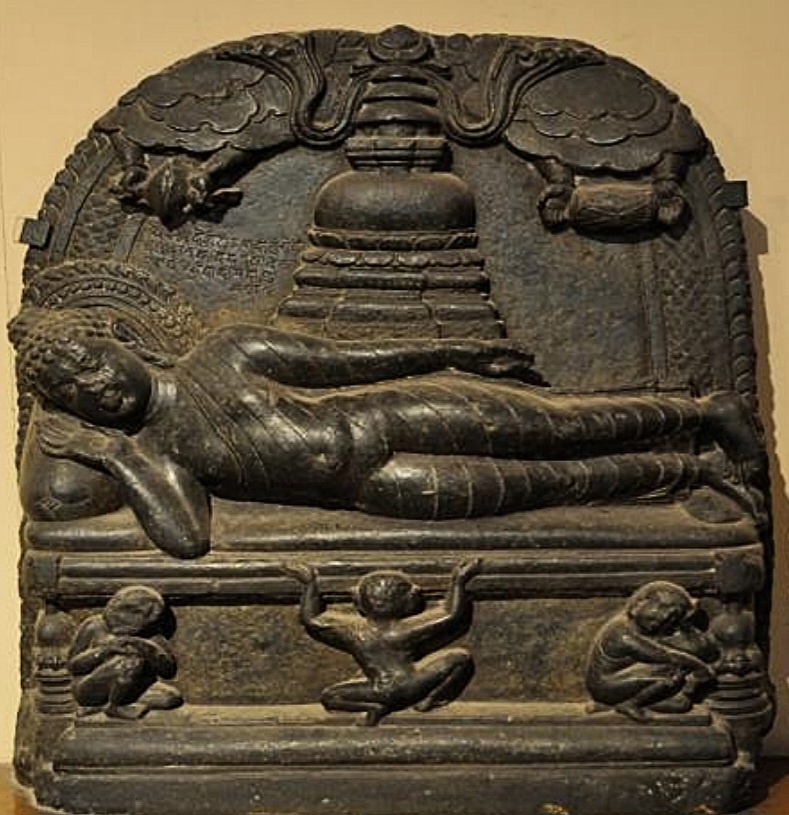
❖ According to Buddhist tradition, the Buddha died at Kushinagar,India which became a pilgrimage centre.
❖ Ananda protested the Buddha’s decision to enter Parinirvana in the abandoned jungles of Kushinagara of the Malla kingdom.
❖ It is believed that his last words were, ‘All composite things decay, strive diligently’.
Siege of Kushinagar:
❖ Siege of Kushinagar the capital of the Malakas by seven Mahajanapadas’ chiefs and their armies for the posthumous possession of relics of Buddha in 4th century BCE. Depiction of the battle Sanchi stupa railing,1st century BCE.

Buddhist Stupa
❖ After the death of Buddha, nine stupas were erected. Eight of them had the relics of Buddha at their medhi while the ninth had the pot in which the relics were originally kept.

❖ The location of the nine stupas built after the death of Buddha are
➢ Rajagriha
➢ Vaishali
➢ Kapilavastu
➢ Allakappa
➢ Ramagrama (Nepal) remains the only
intact and original stupa containing relics of Buddha.
➢ Vethapida,
➢ Pava
➢ Kushinagar
➢ Pippalivana
❖ Ramabhar Stupa was built over a
portion of the Buddha’s ashes on the
spot where he was cremated by the ancient
Malla people.
❖ Request of the Buddha who had asked that
he be buried under the earth “heaped up as rice is heaped in an alms bowl”.
Buddhism After the Death of Buddha:
❖ Two hundred years after the death of the Buddha, Ashoka embraced Buddhism. This was an epoch-making event.
❖ During the period of Ashoka, the art of stupas reached its climax.
❖ Almost 84,000 stupas were erected during his period.
❖ Although a Vedic tradition, stupas were popularised by the Buddhists.
❖ Through his missionaries Ashoka spread Buddhism into Central Asia, West Asia, and Sri Lanka, and thus transformed it into a world religion.
❖ Even today, Sri Lanka, Burma (Myanmar), Tibet, and parts of China and Japan profess Buddhism.
Representation of Buddha:
❖ White Elephant: Conception/Descent (avakranti)
❖ Lotus and Bull: Birth (Jati) at Lumbini
❖ Horse: Renunciation (Mahabhinishkramana)
❖ Empty Seat: Meditation (dhyana)
❖ Peepal/Bodhi Tree: Enlightenment (Mahabodhi) at Bodhgaya
❖ Lion capital/Wheel: Dhamma Chakra Pravartana – First sermon at sarnath
❖ Footprints: Nirvana
❖ Stupa: Death (Mahaparinirvana) at Kushinagar
Philosophy of Buddhism:
❖ Buddhist philosophy is the elaboration and explanation of the delivered teachings of the Buddha as found in the Tripitaka.
➢ Upali – Vinaya Pitaka – Monastic code
Anand – Sutta Pitaka – Buddha’s teaching
❖ Abhidhamma Piṭaka is a detailed scholastic analysis and summary of the Buddha’s teachings in the Suttas.
❖ Philosophical outline: Its main concern is with explicating the dharmas constituting reality.
❖ A recurrent theme is the reification of concepts, and the subsequent return to the Buddhist middle way.
Various Underlying Meaning of Buddhist Philosophy:
The Buddha:
❖ He cultivated various yogic techniques and ascetic practices and taught throughout north India, where his teachings took hold.
❖ These teachings are preserved in the Pali Nikayas and in the Agamas
❖ Dating these texts is difficult, and there is disagreement on how much of this material goes back to a singlereligious founder.
❖ Focus of the Buddha’s teachings are about
➢ Attaining the highest good of nirvana,
➢ The nature of personal identity,
➢ The process of acquiring knowledge about the world.
❖ Karma and Karmaphala: These are fundamental concepts in Buddhism which explain how our intentional actions keep us tied to rebirth in samsara, whereas the Buddhist path, as exemplified in the Noble Eightfold
Path, shows us the way out of samsara.
❖ Rebirth: It is a common belief in all Buddhist traditions. It says that birth and death in the six realms occur in successive cycles driven by ignorance (avidya), desire (trisna), and hatred (dvesa).
The cycle of rebirth is called samsara. It is a beginningless and ever-ongoing process.
Three Jewels of Buddhism (Triratna):
❖ Buddha (the enlightened)
❖ Dharma (doctrine)
❖ Sangha (commune)
NOTE: The compound Buddhist symbols: Shrivatsa within a triratna,over a Dharmachakra wheel, on the Torana gate at Sanchi.
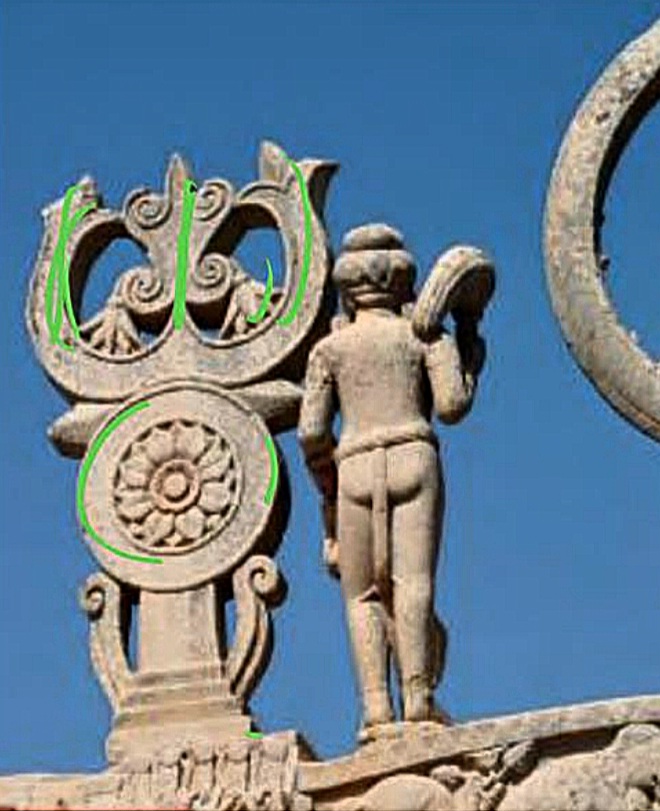
1st century BCE
Four Noble Truth (Chatwari arya Satyani):
❖ Truth of Suffering (Dukkha): Buddha taught that everything is suffering (Sabbam Dukkham). It refers not only to the actual pain and sorrow experienced by an individual, but also to the potential to experience these things.
❖ Truth of the cause of Suffering (Samudaya): Suffering is part of living and there is a reason behind it.
Desire (Trishna) is the main cause of suffering.
❖ Truth of the End of Suffering (Nirodha):This suffering can be ended by attaining Nirvana/Nibbana.
❖ Truth of the Path Leading to the End of Suffering (Astangika-Marga): There is a path that leads to the end of suffering.
Dukkha:
❖ Dukkha, often translated as suffering, is the inherent unsatisfactoriness of life.
❖ This unsatisfactoriness drives our yearning for a better way of life, yet keeps us imprisoned in worldly existence and rebirth.
Eightfold Path:
Although there are many ethical tenets in Buddhism that differ depending on whether one is a monk or a layman,and depending on individual schools, the Buddhist system of ethics can be summed up in the eightfold path: And
this, monks, is the noble truth of the way of practice leading to the cessation of suffering – precisely this Noble Eightfold Path –
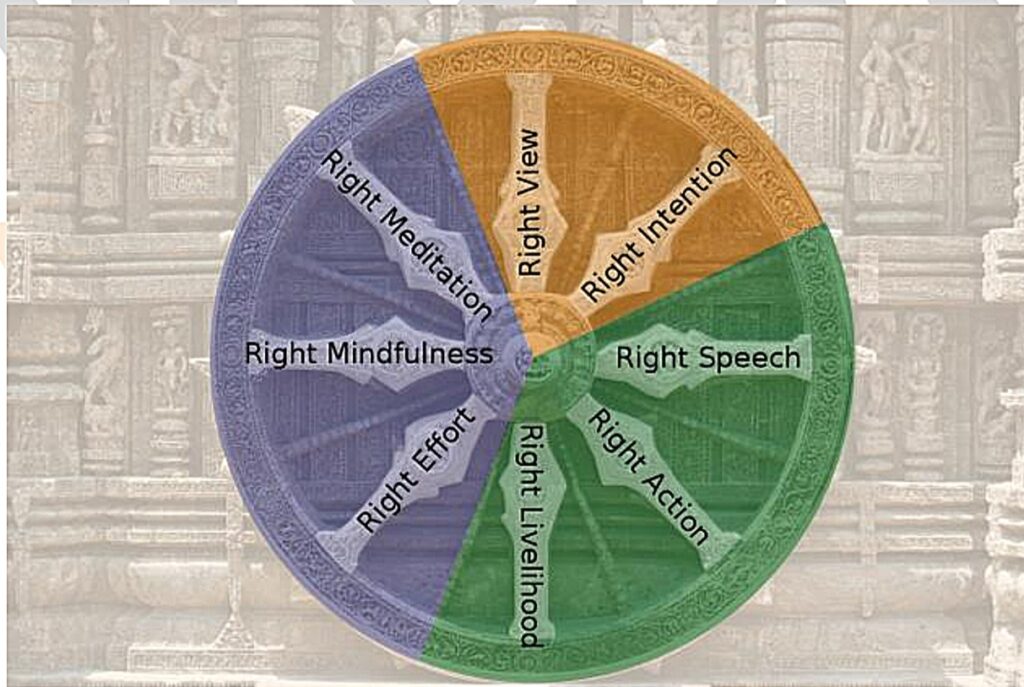
❖ Right view (Samyak Drishti): One can attain right vision by removing ignorance. Ignorance creates a wrong idea of the relationship between the world and the self. It is on account of the wrong understanding of man that he takes the non-permanent world as permanent.Thus, the right view of the world and its objects is the right vision.
❖ Right intention (Samyak sankalpa): It is the strong will-power to destroy thoughts and desires that harm others. It includes sacrifice, sympathy and kindness towards others.
❖ Right speech (samyak vak): Man should control his speech by right resolve. It means to avoid false or unpleasant words by criticising others.
❖ Right action/conduct (samyak karma): It is to avoid activities which harm life. It means to be away from theft, excessive eating, the use of artificial means of beauty, jewellery, comfortable beds, gold etc.
❖ Right livelihood (samyak ajiva): Right livelihood means to earn one’s bread and butter by right means.It is never right to earn money by unfair means like fraud, bribery, theft, etc.
❖ Right effort (samyak vyayama): It is also necessary to avoid bad feelings and bad impressions. It includes self-control, stopping or negation of sensuality and bad thoughts, and awakening of good thoughts.
❖ Right mindfulness (samyak smriti): It means to keep one’s body, heart and mind in their real form. Bad thoughts occupy the mind when their form is forgotten.When actions take place according to the bad thoughts,one has to experience pain
❖ Right concentration (samyak samadhi): If a person pursues the above seven Rights, he will be able to concentrate properly and rightly. One can attain nirvana by right concentration (meditation).
Precepts Right Action (Samyak Karma):
❖ While the precepts for monks and nuns differ somewhat depending on which tradition one has ordained in(Tibetan, Thai Theravada, etc.), the precepts for laymen and laywomen followers of the Buddha are the same.
❖ There are the five precepts that all followers of the Buddha must observe if they hope to be reborn as a human being.
❖ Eight precepts are practised by anagarikas and lay-followers staying in temples.
➢ 5 Moral Vows (Pancha Sila):
✓ Buddha also established code of conduct both for the monastic order and the laymen to follow which are also known as the Five Precepts or Panchshila:
✓ No killing and respect for life.
✓ Abstention from theft.
✓ Abstention from sexual misconduct.
✓ Abstention from falsehood.
✓ Abstention from intoxication.
❖ Ten precepts are followed by bhikkhus or other serious practitioners.
➢ Refrain from killing living things.
➢ Refrain from stealing.
➢ Refrain from unchastity (sensuality, sexuality, lust).
➢ Refrain from lying.
➢ Refrain from taking intoxicants.
➢ Refrain from taking food at inappropriate times (after noon).
➢ Refrain from singing, dancing, playing music or attending entertainment programs (performances).
➢ Refrain from wearing perfume, cosmetics and garland (decorative accessories).
➢ Refrain from sitting on high chairs and sleeping on luxurious, soft beds.
➢ Refrain from accepting money.
Removal of Sufferings:
❖ The removal of suffering then, requires a deep understanding of the nature of reality (prajna).
❖ While philosophical analysis of arguments and concepts is clearly necessary to develop this understanding,it is not enough to remove our unskillful mental habits and deeply ingrained prejudices, which require meditation, paired with understanding.
❖ According to the Buddha, we need to train the mind in meditation to be able to truly see the nature of reality,which is said to have the marks of suffering, impermanence and not-self.
❖ Understanding and meditation are said to work together to ‘clearly see’ (vipassana) the nature of human experience and this is said to lead to liberation.

Nirvana:
❖ Extinguishing the “fires” of desire, hatred, and ignorance, that keep the cycle of suffering and rebirth going.
❖ “end of the world”, in that no personal identity or boundaries of the mind remain.
Core Teaching:
❖ Certain basic teachings appear in many places throughout these early texts, so older studies by various scholars
conclude that the Buddha must at least have taught some of these key teachings:
➢ The four noble truths
➢ The Noble Eightfold Path
➢ Dependent arising
➢ The Middle Way
➢ Three marks of existence (impermanence, suffering, not-self)
➢ Five aggregates
➢ Karma and rebirth
➢ Nirvana

Pratitya-samutpada:
❖ Pratitya-samutpada or the theory of dependent origination is a causal law that states that the nature of all phenomena is conditional.
➢ It means that the production of an effect is out of a complement of cause and conditions, i.e. nothing is spontaneous.
❖ The doctrine of dependent origination is central to Buddhist philosophy and is connected to the second noble truth – suffering has a cause (Dukkha Samudaya).
➢ Other notions, such as the doctrine of karma, the theory of momentariness, and the theory of non-soul are based on this doctrine.
❖ Pratityasamutpada propagates that things have existence, but they are not eternal. An object originates from the other one and destroys itself.
❖ This theory explains bondage and liberation.
❖ It states that events are not predetermined, nor are they random. It rejects notions of direct causation, which are necessarily undergirded by a substantialist metaphysics.
❖ Instead, it believes in the arising of events under certain conditions which are inextricable, such that the processes in question at no time, are considered to be entities.
❖ Dependent origination means that certain specific events, concepts, or realities are always dependent on other specific things.
❖ Everything in the world:
➢ Has cause
➢ Is dependent
➢ Is Relative
➢ Is Conditional
➢ Is subject to birth and death
❖ Hence, impermanent relative i.e., neither absolutely real nor unreal (similar to maya).
Bhava Chakra/Janam Maran Chakra/Samsara Chakra:
❖ It is the vicious cycle of 12 such causes and their effects that governs life.
❖ It does not end with death! But only when the root cause (ignorance) is destroyed.
Avijja (Avidya) Ignorance, Nescience
Sankhara (Samaskara) Volitional formations, Fabrications, constructions, choices
Vinnana (Vijnana) Consciousness, discernment, sense consciousness
Namarupa Name and form, mentality and corporeality, body and mind
Salayatana (Sadayatana) Six sense bases, sense sources, sense media
Phassa (Sparsha) Contact, sense impression, “touching”
Vedana Feeling, sensation, hedonic tone
Avijja (Avidya) Ignorance, Nescience
Sankhara (Samaskara) Volitional formations, Fabrications, constructions, choices
Vinnana (Vijnana) Consciousness, discernment, sense consciousness
Namarupa Name and form, mentality and corporeality, body and mind
Salayatana (Sadayatana) Six sense bases, sense sources, sense media
Tanha (trsna) Craving, desire, greed, “thirst”
Upadana Clinging, grasping, sustenance, attachment
Bhava Existence, becoming, continuation
Jati Birth, rebirth Jaramarana Aging or decay and death.
Anatmavada/Anatta/Anatman/Nairatmavada (Theory of
Denial of the Eternal Soul):
❖ The doctrine of “non-self”, that there is no unchanging,permanent self, soul or essence in living beings.
❖ Soul is only an aggregate of five fleeting skandhas i.e., Rupa(form), Vedana (feeling), Sanjna (perception), Sanskara(tendencies), and Vijnana (consciousness).

❖ Soul is not above this aggregate
➢ Permanent unchanging soul denied
➢ Acknowledged changing self
❖ The Buddha asserted the non-inherently existent concept of the ego, in opposition to the Upanishadic concept of an unchanging ultimate self.
❖ The Buddha held that attachment to the appearance of a permanent self in this world of change is the cause of suffering and the main obstacle to liberation.
❖ The apparent ego is merely the result of identification with the temporary aggregates, the components of the individual human being’s body and consciousness at any given moment in
time.
Other Theories:
❖ Ksanikavada (Doctrine of momentariness)
❖ Sanatanvada (theory of flux or ceaseless flow)
❖ Anityavada (doctrine of impermanence or niccha)
Sanghatvad (Theory of Aggregates):
❖ Soul is only an aggregate of five fleeting skandhas i.e., Rupa (form), Vedana (feeling), Sanjna (perception),Sanskara (tendencies), and Vijnana (consciousness).
❖ Matter is an aggregate of momentary atoms, i.e., everything is momentary and there is nothing permanent.
➢ Body, sensation, perception, dispositions, consciousness all are impermanent and sorrowful.
➢ There is neither being nor non-being, but only becoming.
➢ Reality is a stream of becoming.
➢ Everything is merely a link in a chain, a spoke in a wheel, a transitory phase in a series.
➢ Everything is conditional, relative, dependent, subject to birth and death and thereby impermanent.
❖ Identity is nothing but the continuity of becoming.
❖ Rapidity of succession gives rise to the illusion of unity or Identity.
❖ Impermanent nature of the world → permanent state of nirvana.
❖ Momentariness is again a middle path between eternalism and nihilism.
The Middle Way or Madhyam Maarga or Madhya Pratipada:
❖ The Buddha defined his teaching as “the middle way”.
❖ In the Dhammacakkappavattana Sutta, this is used to refer to the fact that his teachings steer a middle course between the extremes of asceticism and bodily denial (as practiced by the Jains and other sramanas)and sensual hedonism or indulgence.
❖ Many sramanas of the Buddha’s time placed much emphasis on a denial of the body, using practices such as fasting, to liberate the mind from the body.
❖ The Buddha however, realized that the mind was embodied and causally dependent on the body, and therefore that a malnourished body did not allow the mind to be trained and developed.
Do you know?
❖ Majjhima Nikaya a Buddhist text states that the role of Dhamma is akin to a raft.
Nirvana (Vimokha, Vimutti, or Arhatta):
❖ Nirvana is the highest good in Buddhism.
❖ The ultimate goal in life was to attain nirvana.
❖ This could be attained in this life itself. One need not die to attain it.
❖ It is the state of complete cessation of all earthly miseries and sufferings.
❖ Suffering will end by removing desire, and not by practising rituals and ceremonies.
❖ Nirvana is the extinction of the flame of the lamp.
❖ Nibbana literally means extinction or blowing out of desire, ignorance, attachment, greed, hatred.
❖ Nirvana is the experience of the ‘absolute truth:
➢ Nothing is permanent.
➢ Everything is dependent on the other.
➢ Yathabhutam with this realization sees things as they are.
❖ Leads to breaking of bhavachakra (cycle of cause and effect).
❖ Person gets liberation from samsara (cycle of birth and rebirth).
❖ Aftermath of Nirvana or Enlightenment:
➢ Person remains active. Thus, Nirvana is not inactivity.
➢ It works without attachment, hatred etc. and does not cause bondage.
Saupadisesa Nibbana:
❖ Nirvana with remainder
❖ Only passions/desires are extinguished
❖ Saint continue to live
❖ Saint goes through all pleasant/unpleasant sensations until death
❖ Responds to sensations without cravings and with higher knowledge of true nature of things.
Anupadisesa Nibbana (Parinirvana):
❖ Nirvana without remainder.
❖ Death of the saint.
Role of Dhamma as per Majjhima Nikaya
❖ Early Buddhism = agnostic to God
❖ Later Buddhism believed in the = existence of gods and heavens.
❖ Gods/Rituals = cannot help humans in attaining nirvana
➢ Karma – Yes
➢ Atma – No
➢ Rebirth – Yes
➢ God – NA
➢ Rituals – No
❖ Varna System – Recognises but no discrimination or Kshatriya higher status
Was it a Social Revolution or a Religious Revolution?
❖ Buddhism philosophy believes that Nirvana is the personal pursuit on the path told by Buddha and cannot be attained by rituals. It emphasized on karma or right action and gave a code of practical ethics emphasizing on social equality.
❖ Buddhism was for all, irrespective of caste or gender.
❖ It was against the supremacy of Brahmins and caste system (though he did not envisage the elimination of caste) and focussed more on liberal and democratic approach.
❖ Buddhism was critical of the Vedic religion along with its complex and meaningless practices, particularly animal sacrifice.
❖ Buddha asked his followers to stay away from religious and philosophical discussion as far as possible.
❖ Early Buddhism avoided speculative thought on metaphysics, phenomenology, ethics, and epistemology,but was based instead on empirical evidence gained by the sense organs (ayatana).
❖ Nevertheless, Buddhist scholars have addressed ontological and metaphysical issues subsequently.
❖ Particular points of Buddhist philosophy have often been the subject of disputes between different schools of Buddhism.
❖ These elaborations and disputes gave rise to various schools in early Buddhism of Abhidhamma, and to the Mahayana traditions and schools of the prajnaparamita,Madhyamaka, Yogacara etc.
❖ Buddha discouraged his followers from indulging in intellectual disputation for its own sake, which is fruitless, and distracting from true awakening
❖ According to the scriptures, during his lifetime the Buddha remained silent when asked several metaphysical questions.
These regarded issues such as
➢ Universe is eternal or non-eternal (or whether it is finite or infinite),
➢ The unity or separation of the body and the self,
➢ The complete inexistence of a person after Nirvana and death.
Emphasis on Awakening:
❖ Buddha refrained from commenting on metaphysical issues because he thought they serve only to divert attention from practical pursuits of enlightenment and run the risk of replacing the experience of liberation with an intellectual comprehension of the doctrine or religious faith.
❖ Experience is the path most elaborated in early Buddhism.
❖ The Buddha avoided doctrinal formulations concerning the final reality as much as possible in order to prevent his followers from resting content with minor achievements on the path in which the absence of the final experience could be substituted by conceptual understanding of the doctrine or by religious faith.
Emptiness (Shunyavada):
❖ Reality is devoid of sensory mediation and conception, or empty, and therefore language itself is a priori inadequate without direct experience. Thus, the Buddha’s silence does not indicate misology or disdain for philosophy but it indicates that he viewed the answers to these questions as not understandable by the unenlightened.
❖ This provides a framework for analysis of reality that is not based on metaphysical assumptions regarding existence or non-existence, but instead on imagining direct cognition of phenomena as they are presented
to the mind.
❖ This informs and supports the Buddhist approach to liberation from adventitious distortion and engaging in the Noble Eightfold Path.
❖ The Buddha of the earliest Buddhist texts describes Dharma (in the sense of “truth”) as “beyond reasoning” or “transcending logic”, in the sense that reasoning is a subjectively introduced aspect of the way unenlightened humans perceive things, and the conceptual framework which underpins their cognitive process, rather than a feature of things as they really are.
❖ Going “beyond reasoning” means in this context penetrating the nature of reasoning from the inside, and removing the causes for experiencing any future stress as a result of it, rather than functioning outside of the system as a whole.
Buddhist Council
Council Year Venue Chairman Patron Outcome
First 483 B.C.
VENUE – Satparini Cave,Rajagriha Mahakassapa Ajatashatru(Haryanka)
❖ It was held soon after the Mahaparinirvan of
the Buddha.
❖ The council was held with the purpose of
preserving Buddha’s teachings (Sutta) and rules
for disciples.
❖ During this council, the teachings of Buddha
were divided into three Pitakas.
➢ Sutta Pitaka was a collection of Buddha’s
sermons by Ananda.
➢ Vinaya Pitaka contained rules of the order
and was recited by Upali.
❖ Compilation of Suttapitaka and Vinaya Pitaka
by Upali.
Second 383 B.C.
VENUE – Chulla Vanga, Vaishali Sabbakami Kalashoka (Shishunaga)
❖ Since monks of Vaishali wanted some changes in
rites, there was a divide in Sthaviradins &
Mahasangikas.
➢ Sthavaviravadins (Thera in Pali)- Original
spirit of the Buddha’s teachings. Its founder
was Mahachanakya.
➢ Mahasangikas (Great Community)
interpreted more liberally.
Third 250 B.C.
VENUE – Ashokarama Bihar, Pataliputra Mogaliputta Tissa Ashoka
❖ Compilation of Abhidama Pittaka.
❖ The objective of the council was to purify the
Buddhist movement from opportunistic factions.
❖ 60,000 heretical monks were expelled
❖ Origin of Theravada school.
❖ Tripatika is coded in the final form in Pali
language.
❖ Sent Buddhist missionaries to other countries.
Fourth 98 A.D.
VENUE – Kundala Varna (Kashmir) Vasumitra (VC Ashwaghosa) Kanishka (Kushan)
❖ Compilation of Mahavibhasha shastra.
❖ All deliberations were conducted in Sanskrit.
❖ Buddhism is divided into Hinayana (the Lesser
Vehicle) and Mahayana (the Greater Vehicle).
❖ Abhidhamma texts were translated from Prakrit to Sanskrit.
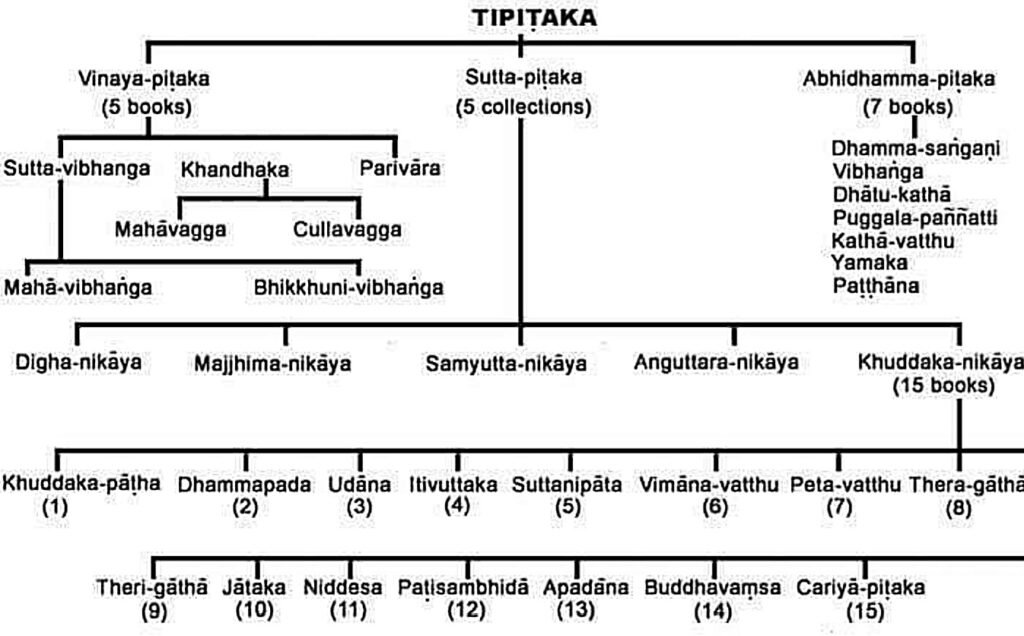
Additional Information:
❖ Some believe that the Fourth Buddhist Council is the name of two separate Buddhist council meetings.
❖ Theravada: Fourth Buddhist Council in 1 c BCE in Tambapanni, i.e. Sri Lanka at Aloka Lena (now Alu Vihara) during the time of King Vattagamani- Abaya.
❖ The second one was held by the Mahayana School, in Kashmir around the 1st century CE. Ashwaghosha participated in this. Commentaries called Vibhasas/ Vibhas Shastra.
Sthaviravāda – Theravada – Hinayana
1. Sarvastivada (c. 237 BCE)
2. Haimavatas
3. Vatsiputriya
4. Sammitiya
5. Dharmottariya
6. Bhadrayaniya
7. Sannagarika
8. Kāśyapiya
9. Mahīśāsaka
10. Dharmaguptaka
11. Sautrāntika
Mahāsāmghika Mahayana
1. Ekavyaharikas (during Asoka)
2. Lokottaravada
3. Gokulika/Kokkutikas (during Aśoka)
4. Bahuśrutiya (late 3rd c BCE)
5. Praiñaptivada (late 3rd century BCE)
6. Caitika Shaitya sailas (mid-1st c BCE)
7. Apara Saila
8. Uttara Śaila
Therigahta: it describes women’s experiences of renunciation and is one of the few surviving ancient texts attributed to women.
Vinaya Pitaka (Basket of Discipline):
❖ It is a compilation of rules of monastic disciplines.
❖ It is observed by monks and nuns in the Sanghas.
❖ Sutta Vibhanga contains:
➢ Patimokkha: the basic code of monastic discipline.
➢ 227 rules for monks (given in Maha-vibhanga).
➢ 311 rules for nuns (given in Bhikkuni-vibhanga).
➢ Also includes list of transgressions against monastic discipline and atonements
❖ Khandaka – two volumes. It includes:
Mahavagga (includes accounts of episodes in Buddha’s life)
Chullavagga (includes accounts of first and second Buddhist councils and founding of the order of nuns).
❖ Parivara (appendix).
Abhidhamma Piṭaka:
❖ It is compiled by Mogaliputta Tissa.
❖ It is a detailed scholastic analysis and summary of the Buddha’s teachings in the Suttas.
❖ It is written in Question Answer form.
❖ Here, the suttas are reworked into a schematized system of general principles that might be called ‘Buddhist Psychology’.
❖ In the Abhidhamma, the generally dispersed teachings and principles of the suttas are organized into a coherent science of Buddhist doctrine.
Buddhist Text:
❖ Mostly written in Pali and Prakrit
❖ Buddhist literature can be divided into Canonical and Non-canonical works.
❖ The Canonical literature consists of “Tripitaka’ or baskets (of knowledge) written in Pali.
Pali Texts
❖ Tripitaka
1. Sutta Pitaka – Buddha’s sayings
2. Vinaya Pitaka – monastic code
3. Abhidhamma Pitaka – religious discourses of Buddha
❖ Milindapanho
❖ Dipavamsa and Mahavamsa (Sri Lanka)
❖ Buddhacarita
❖ Saundarananda
❖ Sutralankar
❖ Sariputra Prakaran
❖ Vajra Suchi (Ashwaghosh)
❖ Mahavibhasa Sastra (Vasumitra)
❖ Visuddhimagga, Athakathayen, Sumangalvasini
Sanskrit Texts
❖ Buddhacarita
❖ Saundarananda
❖ Sutralankar
❖ Sariputra Prakaran
❖ Vajra Suchi (Ashwaghosh)
❖ Mahavibhasa Sastra (Vasumitra)
❖ Visuddhimagga, Athakathayen, Sumangalvasini
❖ Buddhaghosha
❖ Madhyamika karika & Prajnaparimita Karika
❖ Nagarjun
Avadana:
❖ Buddhist literature correlating past lives’ virtuous deeds to subsequent lives’ events.
Milinda-Panha (questions of Milinda):
❖ Monk Nagasena or Nagarjuna debates Indo-Greek ruler Menander.
❖ It is composed by Nagasena/ Nagarjuna.
❖ It is considered as Buddhavacana (word of Buddha).
Mahavamsa (550AD):
❖ It was written by Monk Mahanama epic poem similar to Dipavamsa (350AD), written in Pali language.
❖ It was also called the Chronicles of Kings of Ceylon, etc.
Dipavamsa and Mahavamsa:
❖ It was written in Pali.
❖ Contents:
➢ It is a historical cum mythical account of the Buddha’s life and Buddhist councils.
➢ Ashoka and the arrival of Buddhism to Sri Lanka.
Mahavastu:
❖ It was written in mixed Sanskrit-Prakrit.
❖ Deals with sacred biography, i.e., hagiography of the Buddha.
➢ Hagiography means idealizing biography of a venerated person. It contains Jakata and Avadana tales.
❖ It is written in mixed Sanskrit, Pali and Prakrit. (Mahasanghika related)
Nettipakaraṇa:
❖ The Nettipakaraṇa is a mythological Buddhist scripture, sometimes included in the Khuddaka Nikaya of Theravada Buddhism’s Pali Canon.
❖ The main theme of this text is Buddhist Hermeneutics through a systematization of the Buddha’s teachings.
❖ It is regarded as canonical by the Burmese Theravada tradition, but isn’t included in other Theravada canons.
❖ Avadana is the name given to a type of Buddhist literature correlating past lives’ virtuous deeds to subsequent lives’ events.
Lalitavistara Sutra:
❖ “The play in full” – Mahayana text. – stories associated with the life of Buddha till his first sermon at Sarnath
Udana:
❖ Theravada- “Blind Men and the Elephant”.
Bodhi Vamsa:
❖ It was a prose-poem from, the 12th century in Sri Lanka.
❖ It was translated from a Sinhalese version. It was written by Upatissa in Sanskritised Pali.
Nidanakatha:
❖ It was a first connected life story of Buddha.
Other Texts:
Ashvaghosha (Advisor of Kanishka):
❖ Composed in the first century AD.
❖ He was the first playwright in Indian history.
❖ Famous Books:
➢ Sariputra-prakarana in Sanskrit.
➢ Buddhacharita: He wrote an epic on the life of Mahatma Buddha in Sanskrit
➢ Vajra Suci
➢ Saundarananda: A kavya poem with the theme of the conversion of Nanda, Buddha’s half-brother, so that he might reach salvation.
Nagarjuna:
❖ He was a great teacher of Buddhism.
❖ He wrote:
➢ Satasaharika,
➢ Prajnaparamita (Deals with perfection in various traits)
➢ Madhyamika Sutras.
Buddhaghosa:
❖ Visuddhimagga (path of purification) was composed by Buddhaghosa in Sri Lanka.
❖ It is related to Theravada teachings.
Mahavibhasa Shastra:
❖ It was written in 150 AD.
❖ It consists of discussions about other non-Buddhist philosophies also.
❖ It is essentially a Mahayana text.
Abhidhammakosa:
❖ It was written by Vasubandhu.
Sutralankara:
❖ It was written by Asanga.
❖ It is the earliest book of Yogacara School of Buddhism.
Early Buddhist Schools:
❖ The main early Buddhist philosophical schools are the Abhidharma schools, particularly Sarvastivada and Theravada.
Sarvastivadin:
❖ Sarvastivada is a Sanskrit term that can be glossed as: “the theory of all exists“.
❖ It was one of the early Buddhist schools established around the reign of
Asoka (3rd century BCE).
❖ It was particularly known as an Abhidharma tradition, with a unique set of seven Abhidharma works.
➢ Abhidharma are ancient Buddhist texts which contain detailed scholastic presentations of doctrinal material appearing in the
Buddhist sutras.
❖ Philosophy:
➢ Created a pluralist metaphysical and phenomenological system, in which all experiences of people, things and events can be broken down into smaller and smaller perceptual or perceptual-ontological units called “dharmas”.
➢ It is “the theory of all that exists”. The Sarvastivada argued that all dharmas exist in the past, present and future, the “three times”.
❖ Sub-schools:
➢ Vaibhāṣika
➢ Dārṣṭāntikas and Sautrāntikas
➢ Mūlasarvāstivādins
Different Schools of Buddhism:
Theravada (Hinayana):
❖ It literally means lesser vehicle.
❖ It believes in the original teaching of Buddha or the Doctrine of elders.
➢ This doctrine says that insight must come from the aspirant’s experience, critical investigation, and reasoning instead of by blind faith.
❖ It uses the Buddha’s original teaching preserved in the Pali Canon as its doctrinal core.
❖ Philosophy:
➢ Treats Buddha as a human being.
➢ Does not believe in idol worship.
➢ Tries to attain individual salvation through self-discipline and meditation.
➢ The ultimate aim of Hinayana is nirvana.
❖ Two subjects:
1. Vaibhasika
2. Sautantrika
❖ It is spread in: Sri Lanka, its main bastion, Myanmar, Thailand, and other parts of South-East Asia. Ashoka patronised Hinayana.
Different Sects under Sthaviravada or Theravada or Hinayana:
1. Sarvastivada (c. 237 BCE)
2. Haimavatas
3. Sammitiya
4. Dharmottariya
5. Bhadrayaniya
6. Sannagarika
7. Vastiputriya
8. Kasyapiya
9. Mahisasaka
10. Dharmaguptaka
11. Sautrantika
Mahayana:
❖ The term Mahayana is a Sanskrit word which literally means “Great Vehicle”.
❖ It is a Heterodox school that originated later than Hinayana.
❖ It has two chief philosophical schools.
❖ ‘Vajra’ means absolutely real and indestructible in a human being, as opposed to the fictions an individual entertains about himself and his nature.
❖ This schools of Buddhism appeared in eastern India in the eighth century.
❖ Also, it got established in Tibet in the 11th century due to a mission sent from Vikramshila University – Vajrayana monastery.
❖ Philosophy
➢ Esoteric extension of Buddhist thought and practice
➢ Is a quicker, more effective path to enlightenment.
➢ Salvation can be best attained by acquiring the magical power, which they called Vajra.
➢ It emphasises the role of the Bodhisattva, but favour fierce deities known as the Taras.
❖ It employs:
➢ mantras (esoteric verbal formulas).
➢ mandalas (diagrams and paintings used in visualisation practices)
➢ complex array of other rituals.
❖ Role of the guru in the Vajrayana:
➢ It mastered the philosophical and ritual tradition.
➢ Tibetan translation (lama’, serve both as religious and political leaders. Dalai Lama is the most well-known of Tibet’s lamas.
❖ Language:
➢ Sanskrit language of tantric Indian Buddhism.
➢ Highly symbolic language ‘samdhya-bhasa’ or “Twilight Language too is used.
Dhyani Buddha:
❖ Dhyani-Buddha, in Mahayana Buddhism, and particularly in Vajrayana (Tantric) Buddhism, any of a group of five “self-born” celestial buddhas who have always existed from the beginning of time.
❖ The five are usually identified as
➢ Vairochana – Ether
➢ Akshobhya – Water
➢ Ratnasambhava – Fire
➢ Amitabha – Air
➢ Amoghasiddhi – Earth

Navayana or Neo Buddhism:
❖ Buddhist Movement for Dalits
❖ It was started by B.R. Ambedkar
❖ Ambedkar, with his followers, converted in 1956 in Deekshabhoomi, Nagpur.
❖ Several core beliefs such as the Four Noble Truths and Anatta were not followed, while Karma and Rebirth were considered superstitions.
❖ Navayana as formulated by B.R. Ambedkar re-interpretated in terms of class struggle and social equality.
Chinese Buddhism- Tiantai and the Lotus School:
❖ Tiantai Buddhism under the 4th patriarch, Zhiyi:
➢ Asserted the Lotus Sutra as the supreme teaching.
➢ System of meditation and practices around it.
❖ Other Buddhism: Japanese monk Kukai, founded the Shingon School of Buddhism
Buddhist Scholars:
❖ Moggaliputta Tissa: He launched the campaign of Ashoka’s dhamma.
❖ Asvagosha: He wrote “Buddhacharita” and Sanskrit drama “Sariputra Prakran” (Sariputra – the disciple of Buddha)
❖ Nagarjuna: He founded Madhyamaka school of Mahayanbuddhism, gave theory of “Sunyavad-Emptiness” and important work include “Mulamadhyamakakarika”.
❖ Buddhagosh: He was the most important commentator of Theravada, important work is “Visuddimagga”.
❖ Dharmakirti: He was the teacher at Nalanda, also called as “Kant of India”.
❖ Asanga and Vasubandhu:
1. Asanga was the most significant figure in the Yogachara or Vijnanavada school that his guru, Maitreyanatha, created.
2. Vasubandhu’s most famous book, “Abhidharmakosa,” is still regarded as a significant reference source on Buddhism.
❖ Dinnaga: The last mighty intellectual of the fifth century, also well known as the founder of the Buddhist logic.
Bodhisattvas:
❖ In Mahayana and Vajrayana Buddhist thought, a bodhisattva is a being who is dedicated to achieving complete Buddhahood but delays attainment or Nirvana for the welfare of the people.
❖ Conventionally, the term is applied to beings with a high degree of enlightenment.
❖ Bodhisattva literally means a “bodhi (enlightenment) being” in Sanskrit.
❖ Bodhisattva delays achieving his own salvation to help others on the same path. Amitabha:
❖ Amitabha also known as Amida or Amitayus, is a celestial buddha according to the scriptures of Mahayana Buddhism.
❖ In Vajrayana Buddhism, Amitabha is known for his longevity attribute, magnetising red fire element, the aggregate of discernment, pure perception and the deep awareness of emptiness of phenomena.
❖ According to these scriptures, Amitabha possesses infinite merit resulting from good deeds over countless past lives as a bodhisattva named Dharmakara.
❖ Amitabha means “Infinite Light”, and Amitayus means “Infinite Life” so Amitabha is also called “The Buddha of Immeasurable Light and Life”.
Three Family Protectors:
❖ Out of the eight great Boddhisattvas, Manjusri, Avalokitesvara and Vajrapani are part of the ‘ThreeFamily Protectors’, i.e., the three bodhisattvas who makes of the trinity that protects the Buddha and represents his key virtues as:
➢ Manjusri represents the Buddha’s wisdom.
➢ Avalokitesvara represents his compassion.
➢ Vajrapani represents his power.
Eight Great Bodhisattvas:
1. Manjushri (Bodhisattva of Wisdom):
❖ Role: wisdom and insight
❖ Appearance and Depiction:

➢ Depicted with a sword in his right and a text in his left hand.
➢ Right hand – flaming sword – symbolises the wisdom that cuts through ignorance.
➢ Left hand – Prajnaparamita sutra, a scripture that signifies his mastery of prajna.
➢ Often, he appears sitting on a lion or lion skin. The lion symbolises the wild mind, which Manjushri shows can be tamed through wisdom.
2. Avalokiteshvara/Padmapani/Lokesvara (Bodhisattva of compassion):
❖ Role: infinite compassion.
❖ Appearance and Depiction:
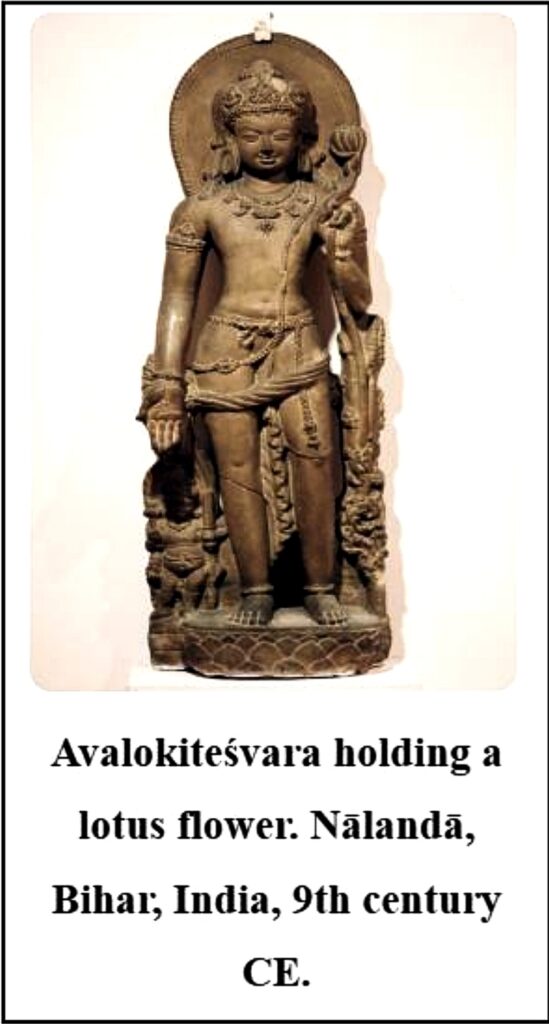
➢ Usually depicted as white in colour and holding a lotus.
➢ Avalokiteshvara is venerated as the ideal of karuna.
✓ Karuna is the activity of compassion in the world and the willingness to bear the pain of others.
➢ “The One Who Hears the Cries of the World”; “The Lord Who Looks Down”; “The Lord Who Looks in Every Direction.”
3. Vajrapani:
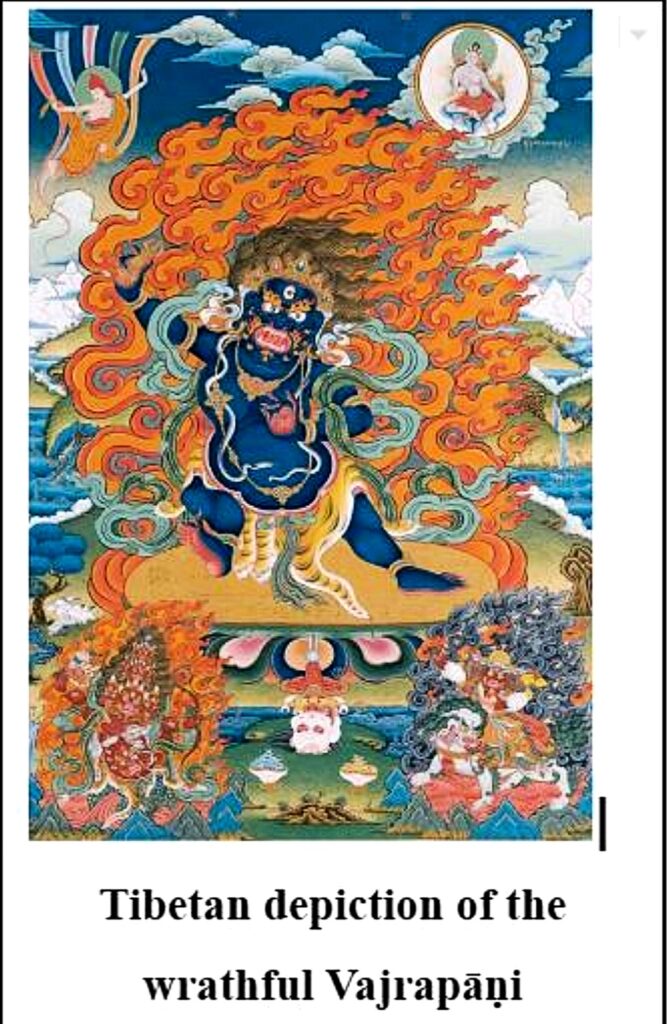
❖ Role: represents power and forceful energy.
❖ Appearance and Depiction:
➢ Usually depicted as blue in colour
➢ Holding a Vajra (a lightning bolt) in his right hand.
➢ Covered in flame with a fierce pose and fiercer face.
➢ Depicted standing in a warrior pose and surrounded by fire,
➢ Represents the power of transformation.
4. Maitreya:
❖ Role:
➢ Who has not lived yet.
➢ Who is predicted to arrive in future as a saviour figure.
➢ Expected to bring true Buddhist teachings back into the world after their decline.
➢ Also known as Future Buddha.
❖ Appearance and Depiction:
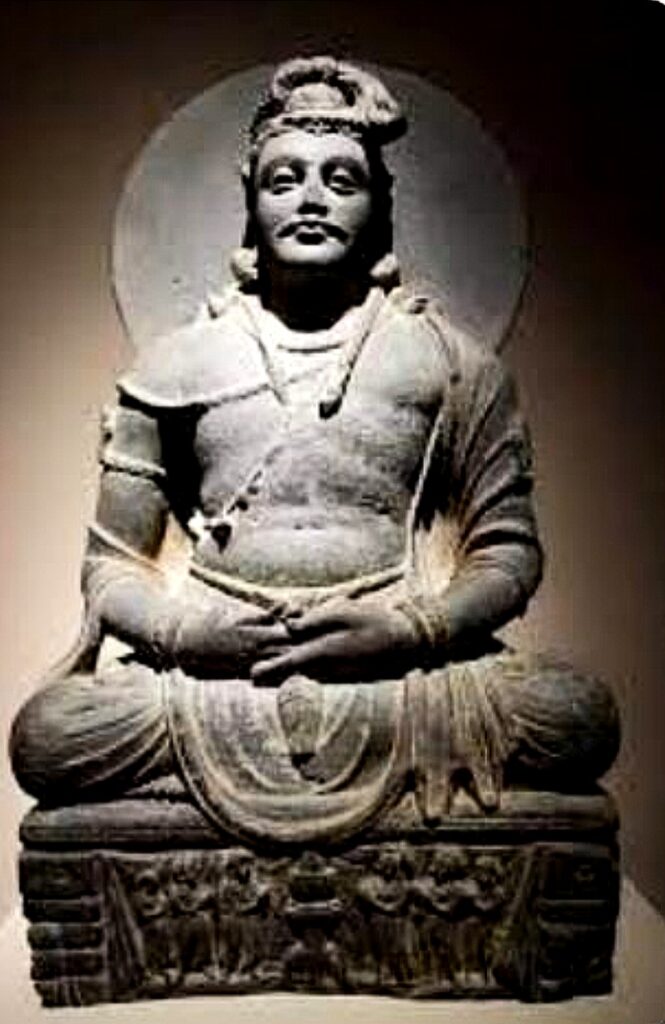
➢ Since Maitreya is currently waiting to enter the world, he is usually depicted sitting and waiting
➢ Often painted orange or light yellow wearing a khata (a traditional scarf made of silk) and holding an orange bush, symbolising his ability to distance distracting and destructive emotions.
5. Kshitigarbha (Savior of Beings in Hell):
❖ Role: Famous for bowing to save the souls of all beings between Buddha’s death and the age of Maitreya, including the souls of children who died young and those in hell.
❖ Appearance and Depiction:
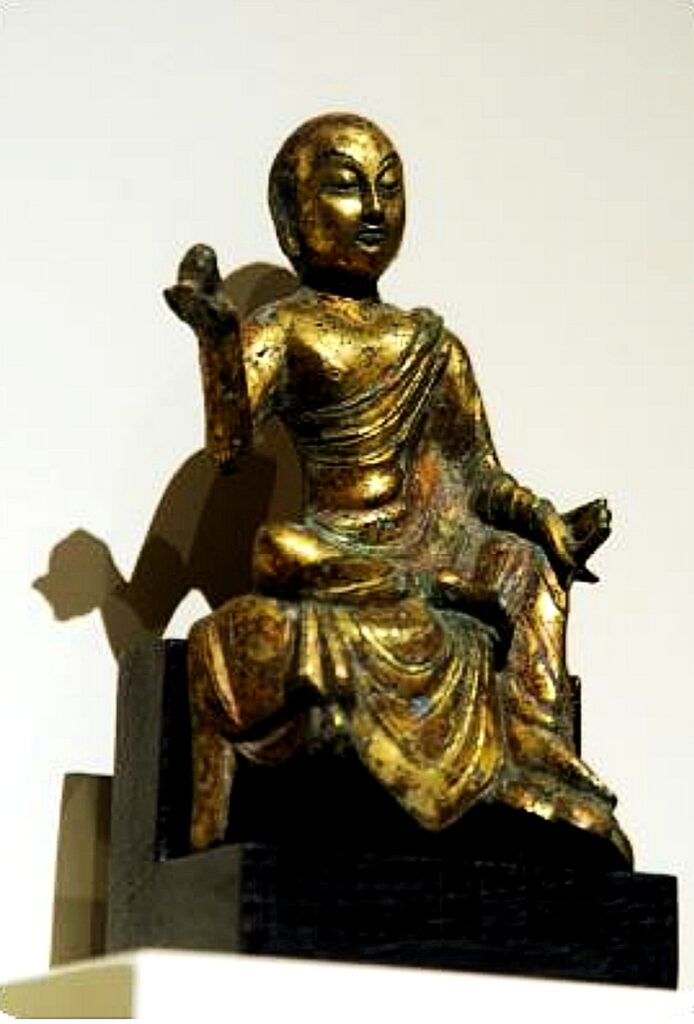
➢ As opposed to most bodhisattvas who appear wearing the luxurious robes of royalty, he wears simple monk’s robes.
➢ He carries a staff which he uses to open up the gates of hell in one hand, and in another he holds a jewel called a cintamani that has the power to light up darkness and grant wishes.
❖ Kshitigarbha-“Womb of the Earth”
❖ Known as Ti-ts sang or Dicang in China and Jizo in Japan.
❖ He is venerated as the savior of beings in hell and as a guide to deceased children.
❖ Kshitigarbha has vowed not to rest until he has emptied hell of all beings. He is also the protector of living children, expectant mothers, firemen, and travellers.
❖ The six rings indicate that the Bodhisattva protects all beings in the Six Realms.
❖ Often his feet are visible, representing his ceaseless travels to all who need him.
6. Akashagarbha:
❖ Role: It has the ability to purify transgressions and is known as the twin brother of Ksitigarbha.
❖ Appearance and Depiction:
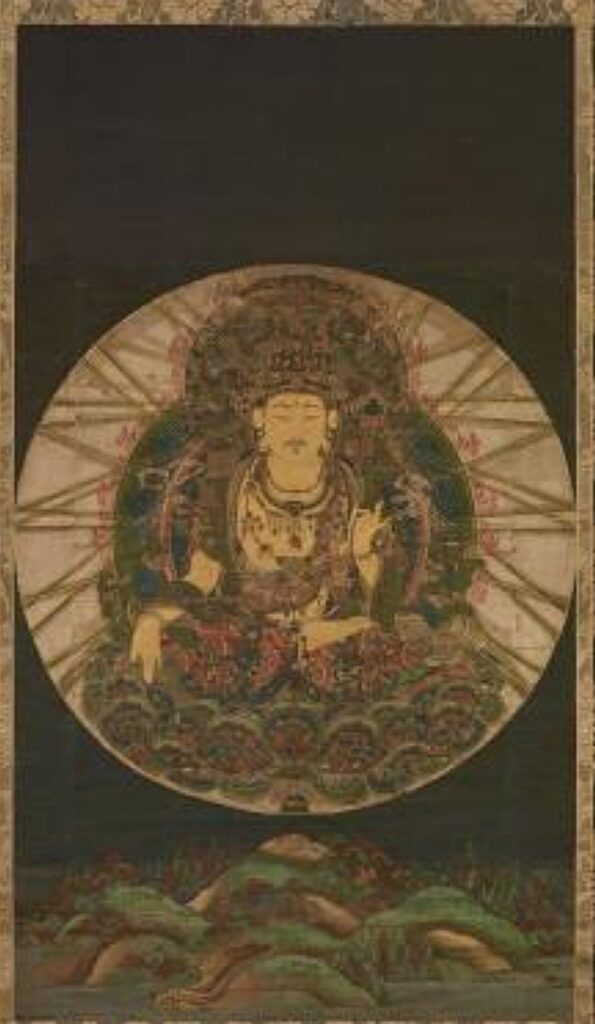
➢ It is depicted with either blue or green skin wearing ornate robes and with a halo around his head.
➢ He generally appears in a peaceful meditation pose sitting cross-legged on a lotus flower or standing calmly on a fish in the middle of the ocean and carries a sword to cut through negative emotions.
7. Samantabhadra (Icon of Practice):
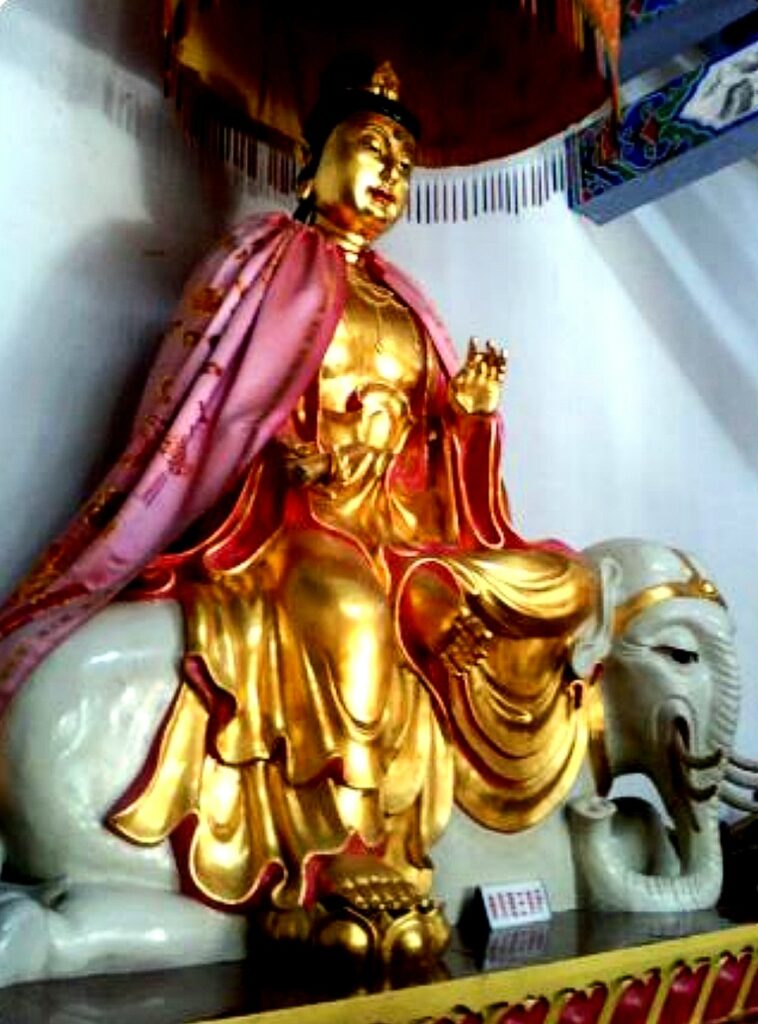
❖ Role:
➢ Meaning ‘Universal Worthy’.
➢ It refers to fundamental and unchanging goodness.
➢ Alongside Shakyamuni Buddha (also known as Gautama Buddha) and the bodhisattva Manjusri, he forms part of the Shakyamuni Trinity and is famous for his ten great vows.
❖ Appearance and Depiction:
➢ He is almost always riding an elephant with six tusks, or three elephants at once.
➢ Symbolically, these six texts represent the Paramitas (Six Perfections).
➢ Paramitas: charity, morality, patience, diligence, contemplation and wisdom.
❖ He is the protector of those who teaches the Dharma and represents the meditation and practice of the Buddha.
❖ Samantabhadra often is part of a trinity with Shakyamuni Buddha (the historical Buddha) and Manjushri.
❖ In some traditions, he is associated with Vairocana Buddha.
❖ In Vajrayana Buddhism is he the Primordial Buddha and is associated with the dharmakaya.
❖ In art, he is sometimes depicted as a woman, sometimes a man. He may ride a six-tusked elephant, carrying a lotus or parasol and a wish-fulfilling jewel or scroll.
❖ In Vajrayana iconography, is he naked and dark blue, and joined with his consort, Samantabhadri.
❖ He is the patron of the Lotus Sutra and, according to the Avatamsaka Sutra, made the ten great vows which are the basis of a bodhisattva.
8. Sarvanivarana-Vishkambhin:
❖ Role: purifies wrongdoing and obstructions, both internal and external, that people face on the path to enlightenment.
❖ Appearance and Depiction:
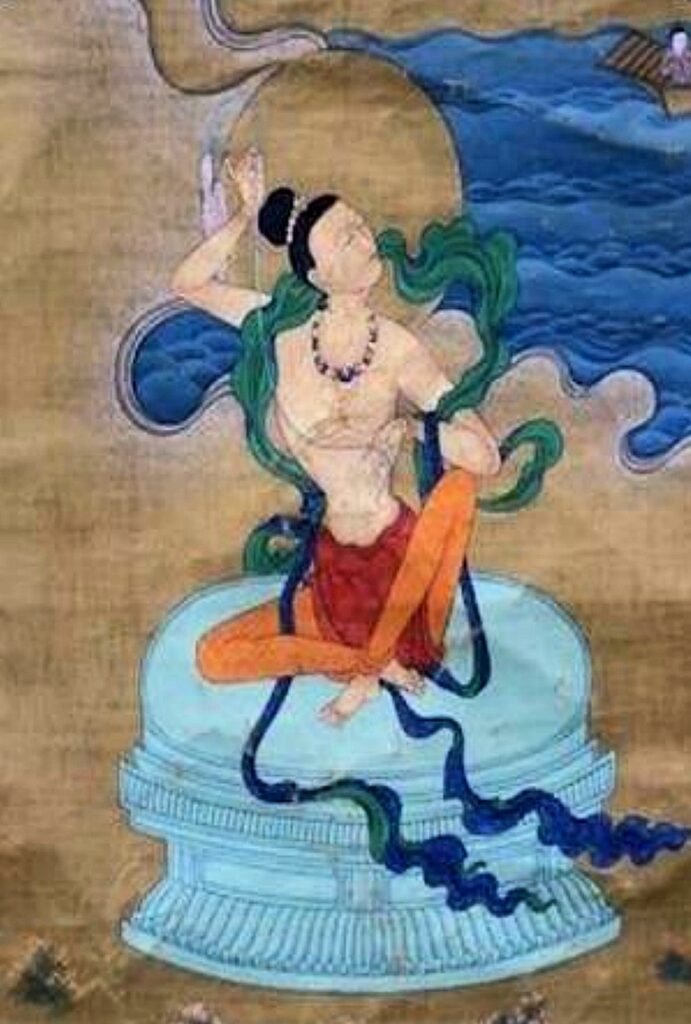
➢ Usually depicted with deep blue skin (associated with royalty) and is seated on a lotus and holding a wheel of jewels.
➢ In addition to blue, the Bodhisattva may also appear white, when his role is to relieve calamities, or yellow, when his role is to provide sufficient provisions.
Causes of Decline of Buddhism:
❖ By the early 12th Century, A.D Buddhism became practically extinct from India.
❖ Prime reasons were:
➢ Rituals and Ceremonies: Originally Buddhism was inspired by the spirit of reform. However eventually it came into the grip of Rituals and Ceremonies. Thus, it became a victim to the evils of Brahminism against which it had fought in the beginning.
➢ Reforms in Brahmanism: Brahmanism on the other hand underwent reforms in order to meet the Buddhist challenge.They stressed the need for preserving te cattle wealth and assured women and shudras of admission to heaven.
➢ Language: Gradually Buddhist monks gave up Pali which was a common language and took to Sanskrit.
Due to this they were cut off from the mainstream of people’s life.
➢ Corruption: From the 1st Century A.D. Buddhism underwent further deterioration. They started practicing idol worship on a large scale and stated receiving numerous offerings from devotees. For example: Nalanda Monastery received revenue from around 200 villages.
➢ Persecution: The Brahmana ruler Pushyamitra Sunga is said to have persecuted the Buddhists.
✓ The Huna King Mihirakula, who was worshipper of Shiva, killed hundreds of Buddhists.
✓ The Shaivite Shashanka of Gauda cut off the Bodhi Tree at Bodh Gaya- the place where Buddha attained Nirvana.
✓ In south India, both shaivites and vaishnavites bitterly opposed Jainism and Buddhism in early
medieval times which further weakened Buddhism.
➢ Turkish Invaders: Buddhist monasteries came under the attack of turkish invaders because of its richness.
Importance and Influence of Buddhism:
❖ Although Buddhism disappeared from India by the 12th century AD, but it had a lasting impact on Indian
history.
❖ Even though the Buddhist monks had abandoned the world and frequently criticized the greedy brahmanas,they shared many traits with them.
❖ They both subsisted on societal gifts or alms and did not work in the production process.
❖ They highlighted the benefits of upholding governmental authority, safeguarding private property, and fulfilling familial commitments.
❖ Both supported the social order based on classes; for the monks, however, the varna was based on action and attributes but for the brahmanas it was based on birth.
❖ The Buddhists developed a new language by the first three Centuries of the Christian Era, known as Hybrid Sanskrit by blending Pali and Sanskrit.
❖ Even during the Middle Ages, Buddhist monks continued to write, and some of the most well-known Apabhramsa works in east India were produced by them.
❖ Buddhist monasteries evolved into outstanding educational institutions that can be referred to as residential
universities. E.g., Nalanda (maha) and Vikramashila (vajra) in Bihar, and Valabhi (maha) in Gujarat
❖ Buddhism left its mark on the art of ancient India.The first human statues worshipped in India were probablythose of the Buddha.
❖ Buddhist devotees portrayed the various events in the life of the Buddha in stone.
➢ The panels at Bodh-Gaya in Bihar and at Sanchi and Bharhut in Madhya Pradesh are examples of artistic activity.
❖ The Greek and Indian sculptors worked together to create a new form of art on the north-west frontier of India known as Gandhara art.
❖ The images made in this region betray Indian as well as foreign influence. For the residence of the monks,rooms were hewn out of the rocks, and thus began the cave architecture in the Barabar hills in Gaya and also in western India around Nasik.
❖ Buddhist art flourished in the Krishna delta in the south and in Mathura in the north.
Important Topics
Ages
Palaeolithic Age, Mesolithic Age, Neolithic Age, Chalcolithic Age
Vedic Period
Early Vedic Period, Later Vedic Period, Vedic literature
Contact Us for Notes ,Full Guidance &Regular Updates

